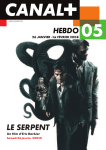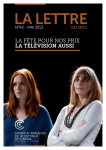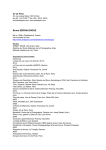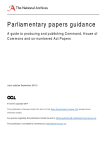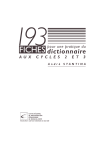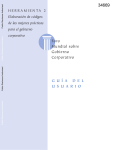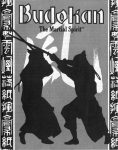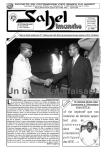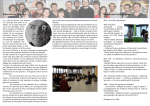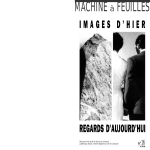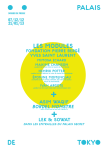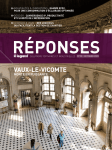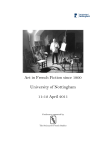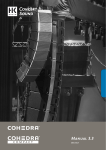Download Oxymoron - Les presses du réel
Transcript
Oxymoron Alexis Vaillant « L’art c’est ce que le monde devient, pas ce qu’il est déjà.” Karl Kraus, Pro Domo Et Mundo I Les coulisses e château de Chamarande est beaucoup plus petit à l’intérieur qu’à l’extérieur. Les étages en ruines ne se visitent pas, et les salles d’exposition n’occupent qu’une petite partie du rez-de-chaussée qu’on voit depuis l’extérieur. Par inversion, ce détail rappelle le scénario de La Maison des feuilles 1, une maison beaucoup plus grande à l’intérieur qu’à l’extérieur, qui disparaît quand on la regarde, et dans laquelle, notamment, il faut trois jours pour atteindre la base d’un escalier visible depuis une porte dérobée. Transposée à Chamarande, cette coïncidence a d’emblée insinué qu’il allait falloir « ignorer » le château en tant que tel, l’oublier. Il fallait qu’en entrant dans le château, on on en sorte. L’isolement indéniable de la bâtisse dans un paysage séculaire, comme infini, confère à l’ensemble du domaine un côté hors du monde, voire hors du temps, presque science-fictionnel, au sens où son futur n’a certainement plus d’avenir. Si la dimension intemporelle du site est indubitablement liée au rapport château / paysage / histoire(s) qui le maintient dans le passé, elle L OLIVIA PLENDER Set Sail for the Levant, 2007 Felt pen on paper / Feutre sur papier 50 x 50 cm Courtesy the artist, London 163 ALEXIS VAILLANT découle aussi du rêve de futur que ce domaine séculaire rend impossible, certainement parce que, comme le dit J.G. Ballard, « il se peut que nous ayons déjà rêvé notre rêve du futur et que nous nous soyons réveillés en sursaut dans un monde d’autoroutes, de centres commerciaux et d’aérogares qui s’étend autour de nous comme le premier épisode d’un avenir qui a oublié de se matérialiser » 2. L’endroit semblait donc idéal pour écrire, ou produire, une légende d’aujourd’hui. Il ne manquait plus qu’un écrivain pour en composer le script, un court récit qui fasse imploser les paramètres contemporains en les écrasant dans un futur visionnaire, de l’« histoire écrite d‘avance » comme chez J.G. Ballard qui s’est naturellement imposé. En 1962, l’écrivain publie une nouvelle fulgurante, quasi-cinématographique, dans The Magazine of Fantasy and Science Fiction : « Le Jardin du temps ». En quelques pages, grandeur et décadence, condensation et accélération du temps, travelling et blow-up, instantanné et éternité, netteté et flou, artifice et abandon façonnent la vie d’un couple qui parvient à maintenir à distance une force destructrice qui rôde autour d’un château en cueillant des fleurs du temps. Chaque fleur cueillie devient une glaciale goutte de cristal qui a le pouvoir de maintenir la menace à distance. Vient l’heure de la dernière fleur. La sombre force dévaste les ruines de cristal tout en évitant un buisson de ronces très dense à l’intérieur duquel se trouve le couple, immortalisé côté à côté dans la pierre, une fleur à la main. Quand les rayons du soleil traversent le buisson, leur carnation apparaît l’espace d’un instant. Comme La Maison des feuilles, « Le jardin du temps » aborde des questions de scénarisation d’espace, de modes de regard opérant entre périphérie et centre, de différences entre environnement et contextualisation, d’espaces de mesure qui 164 OXYMORON contiennent la durée de leur transformation, d’animisme, et de jeux d’échelle architecturaux : autant d’élements de « scénarisation du réel » – pour reprendre les mots de Walter Benjamin – utiles pour articuler l’exposition d’œuvres d’aujourd’hui dans un château improbable. De quel aujourd’hui s’agit-il ? Comme l’a remarqué Alan Greenspan, la chose la plus étonnante qui soit arrivé à l’économie après le 11 Septembre est que rien ne lui soit arrivé. Cet événement vite absorbé par une économie capitaliste globale considérablement plus flexible, ferme, ouverte, auto-dirigée et changeante qu’au début des années 90, a renforcé la perception d’un monde nouveau où l’événement a pour corrélat la légende 3. Le 11 septembre « est un acte terroriste qui ressuscite à la fois l’image et l’événement » 4, du grand spectacle avec des vrais meurtres. Traditionnellement, la légende est véhiculée par des fables et des récits basés sur des secrets, des mensonges, des manipulations et des exagérations de vérités historiques et populaires. C’est une parole archaïque qui circule en lien étroit avec les images. Elle se rapproche en cela de l’imaginaire. Logée dans le passé, la légende n’a a priori rien à voir avec le présent continu dans lequel notre époque est plongée. Pour autant, ce présent génère du récit. Ce récit est communicationnel et digital. Il est dopé à l’« hystérie point-com », et repose sur les quinze secondes de célébrité reconduites en boucle imposant un nouveau schéma : accélération généralisée vs disjonction instantannée. Ses archives sont promotionnelles, et 2050 constitue l’horizon ultime des prédictions qui l’animent. Mais parce que ce présent n’existe qu’à travers le futur supposé qu’on lui prête, et que la masse d’archives qui en découle est quas-inexploitable – parce que cet excès de mémoire a pris la forme d’un souvenir, le souvenir du présent pour reprendre les mots de Paolo Virno 5 – , il est de plus 165 ALEXIS VAILLANT en plus probable que l’histoire devienne impossible à écrire (notamment à partir de telles archives), et que l’on bascule du côté de la légende. C’est sur cette hypothèse, qui découle ellemême de ces observations, que l’exposition « Légende » repose. Et parce que « quand la légende devient réalité, il faut imprimer la légende ! » 6, l’exposition se devait d’être massive, immersive, aussi contradictoire que le présent dans lequel elle s’enracine, questionnante, inédite, extrême, sur mesures. Le plan du bâtiment remonte au XVIIe siècle : style austère version rustique. La principale élévation date du XVIIIe. Des people en font un lieu chaud. Au milieu du XIXe siècle, une partie de l’intérieur est relookée néo-gothique et néo-renaissance sous l’impulsion d’Anthony Boucicaut, fils du créateur du Bon Marché. Entre ville et campagne : la vie château. Des clichés des années 1950 montrent un intérieur « white castel » pour ne pas dire « white cube ». Abandonné au tournant des années soixante pour cause de faillite du dernier propriétaire Auguste Mione, le château est squatté par des artistes locaux pré-bios politisés qui se découvrent une âme de châtelains modernes qui revendiquent leurs droits en occupant physiquement la bâtisse. Le Conseil général de l'Essonne achète le domaine en 1978, entreprendune restauration « façon XIXe » de l'intérieur avec l'aide des Bâtiments de France dans les années 1980-1990, le tout étant sensé « évoquer et représenter l’histoire ». En 2000, le château devient un centre d’art contemporain dans un cadre paysager. Chose rare à l’ère globalisée, franchir le seuil du château de Chamarande revient à entrer nulle part (si l’on s’en tient à ce que l’Histoire peut avoir d’intégrité). Car si le château se visite comme un bâtiment restauré « témoin » du XIXe siècle, il fonctionne aussi comme un « psychic vacuum » dans lequel les œuvres d’art exposées le plus souvent disparaissent tant 166 OXYMORON l’enveloppe décorative intérieure super exhib qui les contient les englouti. Ces « tensions » sont toujours délicates à gérer, le bâtiment étant classé, aucun trou ni visse n’y est toléré. Et comme je ne suis pas David Copperfield et que Chamarande n’est pas Hollywood, j’ai téléphoné à Yves Godin, concepteurlumière star dans le spectacle vivant, et lui ai proposé, à partir des références littéraires citées, d’idées de scénarisations de l’espace d’exposition, d’un powerpoint des œuvres et d’une présentation des artistes auxquels je pensais, de concevoir un dispositif lumière qui rende l’espace simplement appréhendable. Une heure plus tard, il proposait de recouvrir les neuf cent quatre-vingt-dix huit carreaux des fenêtres de miroirs, ce qui plongeait le château dans l’obscurité, permettait de museler l’empreinte décorative du lieu, de contrôler la lumière artificielle (car à Chamarande il y a plus de fenêtres que de murs), et surtout de faire passer les œuvres au premier plan dans des salles qui avaient dès lors toutes un point commun. La continuité spaciale étant inventée. L’intérieur pouvait commencer à s’estomper et les œuvres fantastiques, inédites et redoutables, entrer en scène. II La scène Dès qu’un bâtiment est classé, il est intouchable. Comme souvent dans les châteaux, le corps principal du bâtiment est étroit, les fenêtres sont omniprésentes et hautes, et les pièces relativement petites. Dans ce contexte, les œuvres exposées sont généralement suspendues à des cimaises (baguettes old-school) et déployées au centre de salle-décors. Elles sont toutes éclairées à la lumière du jour et « rattrapées » par des petits spots version 167 ALEXIS VAILLANT salle d’attente 1986 fixés aux plafonds. Les miroirs d’Yves Godin ont donc permis d’unifier les salles et d’atténuer leurs singularités décoratives ; ils ont multiplié les surfaces, les points de vues, les possibilités d’éclairage – par réflexion notamment – et contribué à mettre le focus sur les œuvres. Ils ont altéré la perception des distances ; donné le sentiment de tourner autour d’un centre sans jamais y entrer. Autant d’« effets spéciaux » qui ont renversé le rapport écrin exposé / œuvres importées. Pour parfaire ce processus de mise à distance du château, quelques modifications de surface ont été nécessaires. Des parois temporaires d’un blanc parfait ont été élevées sur les sols en marbre permettant ainsi d’accrocher des œuvres façon white cube. Les différents carrelages (1860, 1950, 1970) de quatre salles en enfilade ont été recouverts de latex noir mat épais. Les lustres couleur étain ont été déposés ; un large médaillon mural en verre avec scène de chasse néo-antique gay est devenu un soleil opalescent de 4000 watts. Dans une autre salle carrée aux murs gris perle, un sol noir et blanc en damier a été posé à 15° sur de la moquette rouge. Le fond de la bibliothèque (style Empire mais années 1950) « pluggée » sur trois murs a été peint en blanc glacier, éclairé de l’intérieur, ce qui, avec un sol en latex blanc mat inverse le rapport artificiel / historique de la salle : la bibliothèque devenant alors du faux Empire. Dans cette salle baptisée « Cygne Noir » (en souvenir d’une théorie du XVIIe siècle selon laquelle l’exception confirme la règle parce qu’avant tout, elle est l’affirmation de l’imprévu), une vingtaine d’« anomalies » esthétiques contemporaines des plus convaincantes et stimulantes pour l’œil et l’esprit sont regroupées. Parmi lesquelles une mamie-trans entartée provocante et complaisante de Lisa Yuskavage ; un portrait d’homme postDürer au nez anxieux entammé par (trop?) de cocaïne de John 168 OXYMORON Kleckner ; un moteur de montre antropomorphe avec petite pile au niveau du cerveau et aiguille qui décompte les secondes à l’envers de David Musgrave ; un Moïse-Ben Laden que titillent trois mains coupées baladeuses de John Kleckner ; une maison aux asticots avec oiseaux pendus de Dorota Jurczak ; le nuage souriant du non-savoir de Uwe Henneken ; une intense palette brute sur toile intitulée « la date invisible ne garantit jamais l’endroit » de Ellen Gronemeyer ; un visage en céramique comme disparaissant dans de la cellulite vernissée de Klara Kristalova ; une valise en nylon peinte en noir mat et ornée de formes phalliques sommaires discrètement pailletés dans la masse de Karl Holmqvist ; une vidéo de skate furtif noninstitutionnel qui crépite dans un placard bas à moitié fermé de Laurent Vicente ; des écharpes-échantillons composées au sol de Karin Ruggaber, ... Autant d’anomalies (par opposition aux ready-mades actuels) qui flirtent avec l’étrange sans pour autant devenir des curiosités, et qui détraquent notre rapport au présent en y faisant irruption, telles des fulgurances visuelles. Chaque salle porte un nom. Ces noms sont donnés en fonction des œuvres montrées, de l’orientation sud-est, des bonnes et mauvaises vibrations de la salle, de l’intensité de la lumière, de la taille des crémones, au hasard. Certains d’entre eux sont empruntés à La Maison des feuilles de Mark Danielewski comme « le couloir de cinq minutes et demie » et « les constantes : « Température : 0°C +-4 ; Lumière : absente ; Silence : complet (à l’exception du ‘grognement’) ; mouvement d’air (c-à-d brise, courant d’air, etc.) : aucun ; Nord véritable : INEX. ». D’autres viennent de Billenium de J.G. Ballard comme l’équation « $ Enfer x 10 n » ou de Dreams, L’exposition dont vous êtes le héros, un plan d’exposition conçu par Pierre Joseph 7 en 1990 dont une salle – « L’homme en damier » – avait un sol en damier. Il y 169 ALEXIS VAILLANT a aussi : « Abou Simbel=Légende Dorée » dans laquelle une branche stalactite goth-hard-rock cristallisée de Skafte Kuhn ignore magistralement le cercle lumineux mystico-matérialiste de Benedikt Hipp et une structure en plaques d’acier qui ressemble à un énorme chapeau de sorcière sur pattes de Jason Meadows. Dans « Le salon ovale » une prêtresse-trans-Pierrot orientaliste en suspension entre des planètes (Malaya, 2002) de Alan Michael cotoie une frite en bronze sortie d’une caisse en bois avec mains maladives et regard triste (V.O.T.E # 79, 2007) de Uwe Henneken tous deux bercés par le Théâtre de poche (2007) de Aurélien Froment dans lequel un magicien fait tenir en suspension plusieurs millénaires de productions humaines en dix minutes. Dans « 12h01 » avec le gigantesque Andy de Tomoaki Suzuki qui regarde un post-it accablant intitulé Note to Self (2007) de Philip Newcombe qui présume de la mort de celui ou celle qui le lit. Pour « L‘entre-monde », Ulla von Brandenburg a cousu deux costumes d’acrobates pied à pied qu’elle a suspendus comme un étendard au dessus de la porte d’entrée du château Untitled (Fahne) (2008), ... Dans « Non Monde » Jordan Wolfson a souhaité réunir sa vidéo Neverland (2001) – du nom de la demeure de Michael Jackson – sur laquelle on peut voir les yeux de la pop star, seule partie non retouchée d’un corps ici complètement effacé, à côté d‘une photographie d’un portrait de Helen Keller (2007) avec le front comme éblouit par le flash de la rephotographie – « no world » étant l’expression que Helen Keller née aveugle, sourde et muette a utilisé pour qualifier le monde depuis lequel elle écrivait ses contes pour enfants – créant ainsi une circularité conceptuelle qui augmente l’absence de centre physique et dramaturgique / narratif de l’exposition. Pour que la légende dépasse l’évocation et l’hypothèse de travail, 170 OXYMORON et que son côté épique fonctionne (les bonnes légendes sont toujours peuplées), il fallait beaucoup d’artistes, des œuvres très récentes, et un accrochage conçu sur mesures pas tant à cause du lieu que des contradictions inhérentes à l’exposition de ces œuvres apparemment hétérogènes. Toutefois, pour déplacer cette polymorphie, chaque salle est augmentée d’un haiku qui brouille, dérange, sépare, réévalue, renverse le côté « dispersion visuelle » de chaque salle. Ces haikus figurent uniquement sur le plan détaillé de l’exposition donné à l’entrée. Le haiku est un court poème en trois vers de 5/7/5 syllabes. Forme poétique pratiquée au Japon depuis le XIIe siècle, le haiku suscite, par les mots, un mouvement de l’esprit vers la chose comme elle est. En disant la chose ainsi, le haiku atteint le côté incontournable de la chose, sans question ni raison ni arrière-pensée spéculative. Le haiku ne formule pas, il appréhende, sans exprimer, tout en pointant. Il traque l’inconnu au cœur du familier et fait surgir une image devant l’esprit. L’inattendu, alors, opère dans une immédiateté saisissante. L’illumination subite que le haiku provoque est aux antipodes de la réflexion conceptuelle. « Le haiku plaide pour un esprit désoccupé, un esprit qui se laisse habiter », il ouvre sur une « réalité qui questionne la prétendue ‘solidité’ du monde » 8, comme la plupart des œuvres de l’exposition. Chaque haiku est un filtre de vision. Il peut aussi bien faire diversion sur le seuil d’une salle qu’accompagner et déformer le souvenir de l’impact visuel qu’on en a. Toute l’exposition se trouve donc « haikuïsée ». On peut lire par exemple : « De plus en plus froid – le téléphone noir de la nuit » (Sumitaku Kenshin 1961-1987) dans ‘Le trou noir’ ; « Le papillon bat des ailes comme s’il désespérait de ce monde » (Kobayashi Issa 1763-1827) dans ‘L’homme en damier’ (Pierre Joseph) ; « La pluie d’hiver montre ce que voient nos yeux 171 ALEXIS VAILLANT comme si c’était chose ancienne » (Yosa Buson 1716-1783) dans ‘Non monde’ ; « Silencieux dans la nuit qui tonne – l’ascenceur » (Saitô Sanki 1900-1962) sur ‘Les 27 marches’ ; ... Les haikus complètent, orientent, augmentent, neutralisent, déplacent, l’impact visuel de chaque salle parce qu’ils ne sont pas « raccord » avec ce qui est exposé et génèrent instantémment une image mentale en dehors de tout contrôle. Dans ce sens, le haiku déroute les neurones au cœur d’une perception esthétique (la visite de l’exposition) et de l’expérience de sa rémanence (une déambulation cinématographique). Si le haiku n’est pas « raccord » avec les œuvres, il les emmène toutefois avec lui (et vice et versa). Les rapports qui en découlent concernent le monde tel qu’il est. Car en testant la « prétendue solidité » du monde, les haikus et les œuvres rappellent que la capacité à brouiller, déranger, prendre à contre-pied, renverser les attentes découle d’une conscience des enjeux susceptibles d’anticiper et perturber une époque pas vraiment préparée pour l’imprévisible. III Les perspectives Décembre 2007. Los Angeles. Cimetière de Westwood Memorial Park. Entre un petit building carré climatisé, quelques bâtisses néo-égyptiennes années 1910 et un parking post-moderne à ciel ouvert : la tombe de Marylin, anonyme. Une rose fraîche honore les cendres de la star. Comme toutes les légendes depuis le big bang, Marylin est une image, pas les cendres. Elle est une image parmi nous, entre nous. Années 00, l’artiste anglais Mark Leckey raconte qu’il vit dans un monde bi-dimensionnel. Pour lui, certaines idées, et à 172 OXYMORON fortiori certaines œuvres d’art, des morceaux de littérature, de musique, de mode, de presse notamment, produisent du relief dans un monde plat. A l’heure du décodage automatique (l’être humain comme scanner) et du tout expliquable (les médias et le politique comme garants auto-proclamés du « savoir » à court terme), cette vision rappelle que toutes les œuvres / concepts / idées ne sont pas interchangeables, et que seuls certains d’entre eux « brisent la surface ». Si l’image de Marylin incarne cette platitude à l’infini, l’observation de Mark Leckey en inverse le cours. Ce qui produit du relief aujourd’hui n’est pas ce qui est immédiatement assimilé par la communication (une seule face jouée 24h sur 24) mais ce qui produit de l’imaginaire à l’intérieur des systèmes fermés de communication (Philippe Parreno). Ce « relief » a à voir avec le rien, au sens où, au départ, il n’y a rien : rien avant l’irruption et rien comme substance ultime du monde. Nombreux sont les artistes qui ont évoqué l’ampleur du rien qui habitait leur temps, anticipant le nôtre : « Rien. Presque » (Marcel Duchamp), « Maintenant est venu le temps d’attaquer le problème du rien » (General Idea, 1973), « le rien est parfait parce qu’après tout il ne s’oppose à rien » (Andy Warhol, 1975), « Nouvelles manières de rien faire » (Karl Holmqvist, 2003). Cette légende parle de rien mais elle le fait avec des œuvres qui ne se contentent pas du monde tel qu’il est déjà mais qui (se) mesurent (à) ce qu’il devient. La plupart des œuvres exposées dans « Légende » fonctionnent dans cette dynamique. Qu’elles soient décoratives, enthousiasmantes, inopportunes, inconfortables, rébarbatives, séduisantes, classiques, légères, absentes, conceptuelles, matiéristes, réussies importe peu... aujourd’hui. Elles encodent l’époque qui les voit naître, invalident l’idée de chronologie, passent du familier au nonfamilier et inversement, détraquent nos décodeurs ticqués. Un 173 ALEXIS VAILLANT arbre à photos pour table de nuit (Untitled, 2006 de Shannon Bool), des tablettes de chewing-gums enserrées par un piercing pour langue (Gobshite!, 2007 de Philip Newcombe), une bulle de savon programmée pour l’éternité (Forever Lasting Bubble, 2008 de Melvin Moti), une paire de talons en cuir noir avec un pied gauche complètement déformé (Curvings, 2006 de Markus Schinwald), des cristaux et sels qui modifient la surface de bâtons d’acier (Untitled, 2007 de Roger Hiorns), un prototype de jeu de l’oie (Set Sail for the Levant, 2007 de Olivia Plender), un portrait fluo de Frankenstein (Big Frank, 2007 de Jason Meadows), une araignée phallique chocolat-fraise en bronze (Maria, 2007 de Erika Verzutti) sont autant d’artefacts qui démontrent que plus on communique sur eux moins ils se racontent et vice et versa. Une tension qui explique d’ailleurs l’intérêt grandissant, chez beaucoup d’artistes aujourd’hui, pour l’oralité, les anecdotes, la fascination (c’est-à-dire « ce qui empêche de penser » 9), les espaces scriptés : « des espaces que l’on doit traverser physiquement mais que notre esprit vit comme l’exercice d’un fantasme en étant à la fois le site et le processus de l’imagination » 10, et le désir de ne pas illustrer ni de faire un travail sur. Dans ce monde, l’expérience dépend d’une mise en scène, d’un artifice. « Et plus on joue le jeu en sachant que tout est artificiel, que tout était truqué d’avance comme dans Total Recall, plus on vit des expériences pleines et entières. L’expérience aujourd’hui passe par le fait de fabriquer de toutes pièces l’expérience, de saisir l’artifice comme dimension constitutive de la vérité 11. « L’imagination, l’hétérogénité et le désordre apparent des œuvres exposées dans « Légende », préfigurent une vérité actuelle du monde. En 1912, Karl Kraus voyait dans l’art une manière de créer une abstraction du monde, et ce, dans le but de le voir concrète174 OXYMORON ment. Il avait cent ans d’avance. Si Mark Leckey retrouve ce mouvement aujourd’hui, la charge, elle, diffère. Entre-temps, les images nous ont colonisé, et magistralement réunis le 11 septembre. Dans ce mouvement entre bi-dimensionnalité et tri-dimensionalité mentale, individuelle, et collective, la légende occupe une place de choix. Aujourd’hui, l’événement et son devenir légend(air)e se superposent quasi instantannément. Parce qu’elle produit des images en se racontant, la légende se projette. Projetée, elle se matérialise dans la vie, court-circuitant jusqu’à la question même de son devenir (ce qui obsède le présent). Comme le présume Nabokov en ouverture de son dernier roman 12 : « Peut-être que si le futur existait, concrètement et individuellement, sous une forme qu’un bon cerveau pût discerner, le passé offrirait moins de séductions : ses attraits s’équilibreraient avec ceux du futur... Mais le futur n‘a pas cette réalité (que le présent possède et le passé projette) ». Le présent comme légende est un oxymoron 13 qui se réfère de manière schizophrénique au présent que l’on vit et invente à la fois. Ce présent se raconte déjà : c’est notre légende. « Là où l’homme a vécu commence la légende, là où il vit » 14 d'autant plus que, comme le formule David Lieske, « Tout ce qui n'a pas lieu aujourd'hui n'a pas lieu. » 1 Mark Danielewski, La Maison des feuilles, Denoël, Paris, 2003. 2 J.G. Ballard, “Retour au futur grisant” (1993), in Millénaire mode d’emploi, éditions Tristram, Auch, 2008, p. 228. 3 Cf. Alan Greenspan, Le temps des turbulences, JC. Lattès, Paris, 2007. 4 Jean Baudrillard, “L’esprit du terrorisme”, in Le Monde, 2 Novembre 2001. 5 Cf. Paolo Virno, Le Souvenir du présent, essai sur le temps historique, éditions de 175 ALEXIS VAILLANT l’Eclat, Paris, 1999, p. 50. 6 Comme il est dit à la fin du film de John Ford L’Homme qui tua Liberty Oxymoron Valance, 1962. Et comme Jurgis Baltrusaitis l’a écrit en 1957 : « Les illusions et les fictions qui naissent autour des formes répondent à une réalité et elles engen- Alexis Vaillant drent à leur tour des formes où les images et les légendes sont projetées et se matérialisent dans la vie. » 7 Rep. in cat. expo. No Man’s Time, Eric Troncy (éd.), Villa Arson, Nice, 1991, pp. 170-171. “Art is what the world becomes, not what it already is.” 8 Voir Haiku du XXe siècle, Le poème court japonais d’aujourd’hui, Corinne Atlan Karl Kraus, Pro Domo et Mundo et Zéno Bianu (éds.), Gallimard, Paris, 2007, p. 15 9 Voir Patricia Falguières, “Wonderland”, Feu de bois, Alexis Vaillant (éd.), Toastink Press, Paris, Frac des Pays de la Loire, Carquefou, 2004, pp. 65-72. I Backstage 10 Norman M. Klein, The Vatican to Vegas, A History of Special Effects, The New Press, New York, London, 2004. « En décodant l’espace scripté, on apprend comment le pouvoir a exercé son influence entre les classes sous la forme d’effets spéciaux. » (p. 11). Le passage de la bi-dimensionnalité à la tri-dimensionnalité évoqué par Leckey est en ce sens un « effet spécial ». 11 Mehdi Belhaj Kacem, Pop Philosophie, entretiens avec Philippe Nassif, Denoël, Paris, 2005, p. 395. 12 Vladimir Nabokov, La Transparence des choses, Librairie Arthème Fayard, Paris, 1979, p. 11. 13 Association de deux mots apparemment contradictoires qui disent une réalité nouvelle sans pour autant chercher à forger quoique ce soit. 14 Louis Aragon, Le Paysan de Paris (1926), Flammarion, Paris, 2001, p. 15. 176 he castle of Chamarande is much smaller on the inside than the outside. Derelict floors are closed to the public, and the exhibition rooms occupy only a fraction of the ground floor one sees from the outside. This detail might bring to mind the novel The House of Leaves 1, which features a house, on the contrary, much larger on the inside than the outside, a house that vanishes when you look at it, and in which, notably, it takes three days to reach the foot of a staircase spied through an open door. Transposed into Chamarande, this coincidence implied from the start that we needed to “ignore” the castle. And to ignore it, we needed to forget about it. We needed to make it such that by entering the castle, the public could escape it. The marked isolation of the building in an age-old, seemingly limitless landscape confers an out-of-this world, even out-ofthis-time aspect onto the entirety of the estate, one that is almost sci-fi in nature. For Chamarande, the hereafter has no T 177 ALEXIS VAILLANT future. The atemporal dimension of the estate is doubtlessly due to the relationship between the castle, its landscape, and its history (or histories), which relegate it to the past. Yet its atemporality also follows from the fact that this timeless estate proscribes any dream of the future, probably because, as J. G. Ballard says, “it may be that we have already dreamed our dream of the future and have woken with a start into a world of motorways, shopping malls and airport concourses which lie around us like a first installment of a future that has forgotten to materialize.” 2 The location thus seemed ideal for writing, or producing, a contemporary legend. All that was missing was a writer to compose the script, a short story that could implode contemporary parameters in its pulverizing vision of the future, a “history written in advance” like the work of J. G. Ballard, who naturally came to mind. In 1962, J. G. Ballard published a dazzling, quasi-cinematic short story in The Magazine of Fantasy and Science Fiction entitled “The Garden of Time.” Over the course of several pages, grandeur and decadence, compressed and accelerated time, tracking shots and close-ups, immediacy and eternity, order and flux, artifice and abandon construct the story of a couple who manage to deter a destructive force lurking around a castle by cutting flowers of time. Once cut, each flower transforms into an icy droplet of crystal that keeps the menace at bay. Finally comes the hour when the last remaining flower is cut. The dark force then lays waste to these crystal ruins while avoiding a patch of very dense brambles, inside of which lie busts of the couple, immortalized in stone and depicted side by side, a flower of time in their hands. When the sun passes through the bush, their apparition appears for a fraction of a second. Like The House of Leaves, “The Garden of Time” addresses the 178 OXYMORON portrayal of space within a scenario, the ways of looking that operate between periphery and center, the difference between environment and contextualization, the measurable duration of spaces, the intervals of transformation, animism, and the architectural plays of scale that are among the many elements of “the scripting of reality”—to quote Walter Benjamin—that help articulate the exhibition of modern-day work in this unlikely castle. Yet exactly which modern day are we talking about? As Alan Greenspan once remarked, the most incredible thing that happened to the economy after 9/11 was that nothing happened at all. The event was quickly absorbed by the global capitalist economy, one vastly more flexible, resilient, open, self-directing, and volatile than it was in the 1990s. This rapid absorption reinforced the image of a new world where event and legend go hand in hand3. September 11th was a “terrorist attack [that] revived both the image and the event,”4 like a grand spectacle with real murders. Traditionally, legends are spread by fables and stories based on secrets, lies, manipulations, and exaggerations of historical and popular facts. Legend is archaic speech that circulates in close connection with images. As such, it comes close to the imaginary. Lodged in a distant past, legend initially seems to have nothing in common with this era’s perpetual present. And yet, the present produces its narratives too. Today’s story is communicational and digital. It is strung out on “dot-com hysteria” and fifteen seconds of fame run on a loop, imposing a new scheme: generalized acceleration versus instantaneous disjunction. Its archives all serve to promote something in the present, while its future horizons extend no further than 2050 AD. But this present-day only exists through the hypothetical future we grant it, and the mass of archives that flow from it remain difficult to exploit because this 179 ALEXIS VAILLANT profusion of memory has become the memory of the present, to take up the words of Paolo Virno5. It is thus increasingly likely that history is becoming impossible to write (using, in particular, such archives) and that we are tumbling over to the edge of legend. The exhibition “Legend” is based on this hypothesis, which itself emerged through these observations. And because, as John Ford once said, “When legend becomes reality, print the legend!” 6, the exhibition had to be massive, consuming, as contradictory as its current climate, critical, unexpected, extreme, and made-to-measure. The blueprints go back to the seventeenth century, when the building was an austere, vaguely rustic version of its present self. The majority of construction took place in the eighteenth century. Various personalities enlivened the spot. In the midnineteenth century, part of the interior was remodeled in a neogothic and neo-Renaissance style under the direction of Anthony Boucicaut, son of Bon Marché founder Aristide Boucicaut. Castle life occupied a middle ground between city and countryside. Some 1950s clichés materialized in a “white castel” interior, not to say a white cube. Abandoned around the 1960s following the bankruptcy of its last owner, August Mione, the castle was squatted by local pre-organic politicized artists, who claimed their rights by physically occupying the building. The District Council of Essonne bought the estate in 1978, and undertook a “nineteenth-century style” restoration of the interior with the aide of Bâtiments de France, the French Historical Buildings Society, in the 1980s 1990s, all with the intention of “evoking and representing history.” In 2000, the castle became a regional contemporary arts center. As happens rarely in the age of globalization, to arrive in Chamarande amounts to entering nowhere, from the point of view of holistic 180 OXYMORON history. For while the castle is visited as a restored building that “bears witness” to the nineteenth century, it also functions like a sort of “psychic vacuum” in which the exhibited artworks are often upstaged, if not consumed by, the “exhibitionist” decorative interior. These tensions must be handled sensitively, as the building is a registered historical site and will suffer neither hole nor screw. Since I am not David Copperfield and Chamarande is not Hollywood, I called up Yves Godin, a star theatrical lighting-designer, and with the aide of the literary references cited above, ideas for animating the space, and a Powerpoint of the works and the artists I had in mind, asked him to come up with a lighting design that would make the space simply apprehensible. An hour later, he suggested that we cover the nine hundred ninety-eight window frames with mirrors, thus plunging the castle into darkness and muting the decorative distinctiveness of the site. This would allow us to control the artificial lighting (in Chamarande, there are more windows than walls) and above all, to bring the works to the foreground in rooms that would henceforth all share a common thread. Spatial continuity was born. The interior could begin to disappear and the fantastical, novel, and formidable works, to assume center stage. II The Stage As soon as a building is registered as an historical site, it is untouchable. As is often the case with a castle, the principal body of the building is rather rectilinear; the windows are omnipresent and tall, and the rooms relatively small. Works exhibited in this context are generally suspended from the moldings (old-school picture rails) or placed in the center of the 181 ALEXIS VAILLANT décor-rooms. All works are lit by daylight and cornered by little spotlights affixed to the ceiling that recall the lighting motif in a waiting room from the 1980s. Yves Godin’s mirrors thus allowed us to unify the rooms and to minimize their decorative singularity; his mirrors multiplied the surfaces, viewpoints and lighting possibilities—notably through reflections—and helped focus attention solely on the works. They altered the perception of distances; they gave one the sense of perambulating a center without ever having entered it. These “special effects” inverted the relationship between the display case and the works it contains. To undertake the process of outstripping the castle, some surface modifications were necessary. Gleaming white partitions were set up on top of the marble floors, thus allowing us to hang the works as though in a white cube. The various flooring motifs (1860, 1950, 1970) in four consecutive rooms were covered with thick black latex matte. The pewter-coloured chandeliers were taken down; a large glass wall medallion with a homoerotic neo classical scene was transformed into an opalescent, four-thousand-watt lantern. In another room with pearly grey walls, a black-and-white checkerboard floor was laid down at a bevel, 15 degrees over the red floorboards. Three walls of 1950’s but Empire Style bookshelves were painted glacial white and illuminated from the interior; accompanied by a white latex floor, this inverted the artificial historical relationship of the room, making the original bookshelves an artificial Empire element. This room, baptised the “Black Swan” (in reference to a seventeenth-century theory according to which the exception confirms the rule because it is, above all, the affirmation of the unexpected), reunited twenty contemporary aesthetic anomalies of the most convincing and stimulating order for the eye and 182 OXYMORON the spirit. Among them are: a provocative tarted-up transgranny by Lisa Yuskavage; a post-Dürer portrait with an anxious, cocaine-blasted bashed-up nose by John Kleckner; a motor for an anthropomorphic clock with a battery for a brain and a needle that counts the seconds backwards by David Musgrave; a Moïse-Ben Laden that palpitates three perambulating severed hands by John Kleckner; a house of maggots with hanging birds by Dorota Jurczak; a smiling cloud of “unknowing” by Uwe Henneken; an intensive raw palette on canvas entitled The Invisible Date that Never Guarantees the Place (2006) by Ellen Gronemeyer; a ceramic face that appears to dissolve into cellulite by Klara Kristalova; a nylon suitcase painted matte black and adorned by subtly glittering perfunctory phallic forms by Karl Holmqvist; a furtive, non-institutional skate video crackling from its partial hiding place in a half-closed cupboard by Laurent Vicente; scraps of scarves or cloth compositions laid on the ground by Karin Ruggaber, and more. They work like anomalies (by opposition to the current readymades) that flirt with oddity without necessarily becoming curiosities, derailing our relationship with the present by setting off visual flares within it. Each room has a name. These names were given in accordance with the works they contain, with a south-to-east orientation, with the good and bad vibes of the room, with the light intensity, with the size of the window latches, and randomly. Certain ones were borrowed from Mark Danielewski’s The House of Leaves, such as “The Five and a Half Minute Hallway” and “The Constants: ‘Temperature: 0C +-4; Light: absent; Silence: complete (with the exception of the “groaning”); Air movement (c-to-d draught, air current, etc.): none; True North: INEX.” Others come from J. G. Ballard’s Billenium, such as the equa183 ALEXIS VAILLANT tion “$ Hell x 10 n,” while still others come from Dreams, the Exhibition Where You Are the Hero, an exhibition layout designed by Pierre Joseph7 in 1990 in which one room—“The Checkerboard Man”—had a checkerboard floor. There is also “Abou Simbel=Golden Legend,” in which a branch dripping with crystallized goth-hard-rock stalactites by Skafte Kuhn magisterially ignores the luminous, mystico-materialist ring by Benedikt Hipp and a structure by Jason Meadow’s, made of steel plaques, resembling an enormous witch’s hat on legs. In “The Oval Room,” Alan Michael’s Malaya (2002) features an orientalist priestess-cross-Pierrot suspended between planets, set beside Uwe Henneken’s V.O.T.E # 79 (2007), a bronze French fry with sickly hands and a pout, popping out a wooden box, both of which are disported by Aurélien Froment’s Pocket Theater, in which a magician conjures up for view some several million images of human creations in the span of ten minutes. In “12:01,” Tomoaki Suzuki’s diminutive Andy looks toward Philip Newcombe’s disarming Post-it, entitled Note to Self (2007), which presages the death of its reader. For “The world in between,” Ulla von Brandenburg’s Untitled (Fahne) (2008), twin suits made for symmetrical acrobats, sewn together at the feet, are suspended like a banner above the front entrance. “Non World” is based on Jordan Wolfson’s idea, which brought together his video Neverland (2001)—named after Michael Jackson’s residence—which shows only Jackson’s eyes, the sole untouched feature on the pop star’s erased body, next to a reprint of a portrait of Helen Keller (2007), whose forehead is irradiated by the camera flash. “Non world” is the expression that Helen Keller, born blind, deaf, and mute, used to describe the world from which she wrote her children’s stories—thus describing a conceptual circularity reinforced by the absence of 184 OXYMORON a physical or narrative center in the exhibition. In order to extend “legend” beyond a simple evocation or a working hypothesis, and to fulfil its epic proportions (for good legends are always filled with characters), it was necessary to have lots of artists, recent works, and a made-to-measure display, due not so much to the site as to the contradictions that come from exhibiting these ostensibly heterogeneous works. However, to temper this polymorphy, each room is accompanied by a haiku that obscures, disturbs, separates, re-evaluates, and inverts the “visual dispersion” of the room. These haikus uniquely appear on a detailed map of the exhibition available at the entrance. A haiku is a short poem in three lines of 5/7/5 syllables, a form of poetry practiced in Japan since the twelfth century. Through words, the haiku solicits a movement of the spirit toward the thing as it is. In saying it thus, the haiku captures the incontrovertible essence of its subject, with neither question nor reason nor speculative afterthought. The haiku does not formulate; it apprehends. It indicates without explication. It fetters out the unknown at the heart of the familiar and produces an image before the mind. The unexpected thus occurs with gripping immediacy. The sudden illumination kindled by the haiku stands opposed to conceptual reflection. “The haiku requires a disengaged mind, a mind that lets itself be.” Like most of the works in this exhibition, it deals with a “reality that questions the supposed ‘solidity’ of the world.”8 Each haiku is a filter for the vision. It can as easily serve as a distraction on the threshold of a room as it can escort and distort the memory of its contents’ visual impact. Thus the whole exhibition is ‘haiku-ized.’ One reads, for example, “Colder and colder—the black telephone of the night” (Sumitaku Kenshin 1961–1987) in the ‘Black Hole;’ “The butterfly beats its wings 185 ALEXIS VAILLANT as if he had lost hope in this world” (Kobayashi Issa 1763–1827) in ‘The Checkerboard Man (Pierre Joseph)”; “Winter rain shows what our eyes see as if it were something old” (Yosa Buson 1716–1783) in “Non World;” or “Silent in the thunderous night—the elevator” (Saitô Sanki 1900–1962) on “The 27 Steps.” The haikus complete, orient, enhance, neutralize, and displace the visual impact of each room because they are not necessarily “tuned” to the works they accompany, and instantaneously generate a mental image. In that sense, the haiku reroutes the neurons at the heart of an aesthetic perception (the exhibition visit) and the experience of its afterglow (a cinematographic promenade). If the haiku is not “tuned” to the works, it draws them out with him (and vice versa). The created relationships affect the world itself. Furthermore, by probing the “supposed solidity” of the world, the haikus and the works remind us that the ability to obscure, to disturb, to catch off guard, or to invert expectations, comes from a consciousness of the devastating stakes bound to anticipate and disturb an era as yet unprepared for the unexpected. III Vantage Points December 2007. Los Angeles. Westwood Memorial Park Cemetery. Between a small, square, air-conditioned building, a few neo-Egyptian buildings from around 1910, and a postmodern open-air parking lot, sits Marilyn’s anonymous gravestone. A fresh rose commemorates the star’s cremated remains. Like all legends since the Big Bang, Marylin is an image, not a pile of ashes. She is the image among us, between us. At the beginning of the twenty-first century, the English artist 186 OXYMORON Mark Leckey stated that he lives in a two-dimensional world. For him, certain ideas, and a fortiori works of art and literature, music, fashion, and press produce texture or relief in a flat world. In a time of automatic decoding (where the human being is construed as a scanner) and the all-explainable (where the media and politics are the self-proclaimed keepers of shortterm “knowledge”), this perspective reminds us that not every work, concept, or idea is interchangeable, and that only certain ones among them “crack the surface.” While the image of Marilyn incarnates this platitude, Mark Leckey’s observation inverts it. That which produces texture today is not what (the broken record of ) communication networks can immediately assimilate, but rather what produces imaginativeness inside the closed systems of communication (Philippe Parreno). This “texture” is about nothingness, in the sense that initially, there is nothing: nothing before the outbreak and nothing as the ultimate substance of the world. Numerous artists have evoked the scale of their generation’s nothingness, anticipating our own: “Nothing. Almost” (Marcel Duchamp); “The time has come to attack the problem of the nothing” (General Idea, 1973); “Nothing is perfect because it is opposed to nothing” (Andy Warhol, 1975); “New ways of doing nothing” (Karl Holmqvist, 2003). This legend speaks about nothing, with works that are not satisfied with the world as it stands, but rather that measure the world (or themselves) by what it becomes. The majority of the works in “Legend” operate within this dynamic. Whether they be decorative, enthusing, untimely, seductive, uncomfortable, off-putting, classical, light, absent, materialist, or particularly successful is of little importance... now. They encode the era that produces them, invalidate the idea of chronology, transition from the familiar to the strange and back again, and 187 ALEXIS VAILLANT indicate the idiosyncrasies that anchor our relationship to the present. From a bedside table photo-tree (Untitled, 2006 by Shannon Bool) to pieces of bubble gum squished together by a tongue piercing (Gobshite!, 2007 by Philip Newcombe), to a soap bubble calibrated to last for eternity (Forever Lasting Bubble, 2008 by Melvin Moti), to a pair of black heels with a curved one (Curvings, 2006 by Markus Schinwald), to salt crystals encrusting the surface of steel bars (Untitled, 2007 by Roger Hiorns), to a prototype of a Snakes and Ladders board (Set Sail for the Levant, 2007 by Olivia Plender), to a fluorescent portrait of Frankenstein (Big Frank, 2007 by Jason Meadows), to a phallic chocolate-strawberry spider cast in bronze (Maria, 2007 by Erika Verzutti), these artefacts demonstrate that the more we communicate on things, the less they tell, and vice versa. Such a tension explains the growing interest of many contemporary artists in orality, anecdotes, fascination (that is, “what makes you stop thinking”9), scripted spaces: “spaces that we must physically cross, our spirit lives through an ‘exercise of fantasy,’ being both the ‘site and process of imagination’”10, and the desire to neither illustrate nor make a work about something. In today’s world, experience depends upon performance and artifice. “The more we play the game while knowing that everything is artificial, that everything was rigged in advance like in Total Recall, the more we experience our lives full and whole. Today, experiences are constructed with scraps of experience, by grasping artifice as the constitutive dimension of truth.”11 The imaginativeness, heterogeneity, and apparent disorder of the works of Legend prefigure a current truth about the world. In 1912, Karl Kraus saw in art a way to create an abstraction of the world with the goal of seeing it concretely. He was 100 years 188 OXYMORON ahead of his time. Though Mark Leckey may have rediscovered this same “mental movement” today, the significance is totally different. In the interim, images have colonized us, magnificently converging on September 11th, 2008. In this transition between individual and collective mental two- and three-dimensionality, legend occupies a prime seat. Today, the event and its legend(ary) future are superimposed almost instantaneously. Legends project themselves because they produce images when being told. Thus projected, they materialize in life, short-circuiting even the very question of their future (with which the present is obsessed). As Nabokov muses in the introduction to his last novel12, “Perhaps if the future existed, concretely and individually, as something that could be discerned by a better brain, the past would not be so seductive: its demands would be balanced by those of the future.” The present as a legend is an oxymoron13, one that schizophreni-cally refers to the present we both live and invent. This present is already in the process of telling its own story: our legend. “Legend begins where a man has lived, where he lives” 14 all the more reason that, as asserted by David Lieske: “Everything that doesn't happen today doesn't happen.” 1 Mark Danielewski, House of Leaves, New York, Pantheon Books, 2000. 2 J.G. Ballard, “Back to the Heady Future” (1993), in A User’s Guide to the Millennium: Essays and Reviews, New York, Picador USA, 1996. 3 Cf. Alan Greenspan, The Age of Turbulence: Adventures in a New World, New York, Penguin Press, 2007. 4 Jean Baudrillard, “The Spirit of Terrorism”, trans. Kathy Ackerman, Telos 121 (Fall 2001), p. 140. (Originally published in Le Monde, 2 November 2001) 5 Cf. Paolo Virno, Le Souvenir du présent, essai sur le temps historique, Paris, 189 ALEXIS VAILLANT Editions de l’Eclat, 1999, p. 50. 6 From the end of John Ford’s film, The Man Who Shot Liberty Valence, 1962. As Jurgis Baltrusaitis wrote in 1957, “The illusions and fictions born around forms respond to a reality and, in turn, engender other forms where images and legends are projected or materialize in life.” 7 Rep. in exh. cat. No Man’s Time, Eric Troncy (ed.), Villa Arson, Nice, 1991, pp. 170–171. 8 See Haiku du XXe siècle, Le poème court japonais d’aujourd’hui, Corinne Atlan and Zéno Bianu (eds.), Gallimard, Paris 2007, p. 15. [Translator’s note: The poems here appear translated from the French: Translated from the French: “De plus en plus froid - le téléphone noir de la nuit” (Sumitaku Kenshin 1961–1987); “Le papillon bat des ailes comme s’il désespérait de ce monde” (Kobayashi Issa 1763–1827); “La pluie d’hiver montre ce que voient nos yeux comme si c’était chose ancienne” (Yosa Buson 1716–1783); “Silencieux dans la nuit qui tonne - l’ascenceur” (Saitô Sanki 1900–1962)]. 9 See Patricia Falguières, “Wonderland”, Feu de bois, Alexis Vaillant (ed.), Toastink Press, Paris & Frac des Pays de la Loire, Carquefou, 2004, pp. 65–72. 10 Norman M. Klein, The Vatican to Vegas, A History of Special Effects, The New Press, New York & London, 2004, p. 11. “By decoding scripted spaces, we learn how power was brokered between the classes in the form of special effects”. The transition from two- to three-dimensionality evoked by Leckey is in this sense a “special effect.” 11 Mehdi Belhaj Kacem, Pop Philosophie, interviews with Philippe Nassif, Denoël, Paris, 2005, p. 395. 12 Vladimir Nabokov, Transparent Things, Weidenfeld and Nicolson, London, 1972, p. 1. 13 The association of two ostensibly contradictory words that describe a new reality without, however, seeking to invent it. 14 See Louis Aragon, Paris Peasant, (1926) trans. Simon Watson Taylor, Exact Change, Boston, 1994, p. 11. 190 PLATES / PLANCHES
















